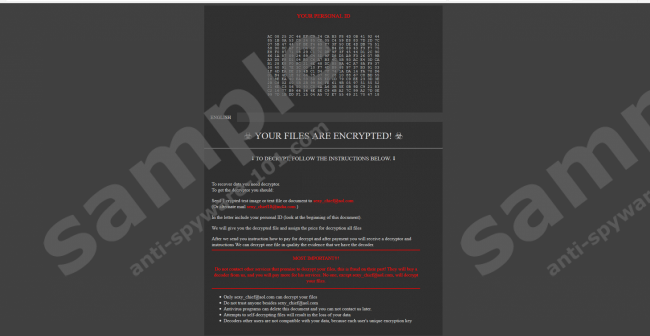What is Sexy Ransomware?
Have you encountered the vicious Sexy Ransomware? If you have, you might have discovered already that some of your personal files were encrypted. According to the analysis of Anti-Spyware-101.com research team, this malware is most dangerous in those cases when personal files are stored in the folders within %APPDATA%, %PUBLIC%, and %ALLUSERSPROFILE% directories. These files might include photos, media content, and text documents. Without a doubt, having your personal files encrypted is a terrible thing because, most likely, you will not recover them. If you are fearful of having your files corrupted, you should set up a backup. Once your files are backed up online or on an external drive, you will not lose access to them even if the original files end up being corrupted. Of course, if backups do not exist, you are more likely to follow the demands listed by the creator of the ransomware, and you are less likely to delete Sexy Ransomware right away. Needless to say, removing this threat is important, and if you want to learn more about the process, please continue reading.

How does Sexy Ransomware work?
Globeimposter Ransomware is the predecessor of the devious Sexy Ransomware. ONI Ransomware was based on this malware as well. When these infections corrupt targeted files, they append unique extension to their names. Sexy Ransomware, of course, adds the “.SEXY” extension. It is very important to check if this malware has encrypted your files because you want to make sure that your files have been jeopardized (that is because many ransomware threats only pose as file-encryptors). You also want to check which files were corrupted because you want to see if backups exist. When you analyze your files, you should be able to find a file named “how_to_back_files.html”. This file holds a ransom note within. At the top of the note, you can find a long string of letters and numbers. This is an ID number created by the ransomware to help identify you, and it is the number you are asked to send to cyber criminals (sexy_chief@aol.com) so that you could receive additional instructions. The ransom note suggests that you can recover your files only if you fulfill the demands of cyber criminals, and that is unlikely to be the truth. In reality, it is unlikely that you can recover your files regardless of what you do.
The ransom note introduced to you by Sexy Ransomware informs that once you initiate communication with the creator, you will get instructions with a specified “price,” which is your ransom. Supposedly, a decryptor would be sent to you as soon as you paid the ransom, but, of course, that is not the case. To intimidate you, the ransom note informs that you should not delete the HTML file. It is also suggested that files would be destroyed if you tried decrypting them yourself. Unfortunately, decrypting files manually is impossible. Free file decryptors will not help either because the encryption key employed by the creator of Sexy Ransomware is unknown. That means that you can recover your files only if backups exist. If you end up losing files, do not forget to set up a backup as soon as you remove the ransomware.
How to delete Sexy Ransomware
Besides figuring out the removal of Sexy Ransomware, you also need to figure out the protection of your operating system. The good news is you can take care of both of these issues using the same instrument: anti-malware software. This software is built to automatically delete existing infections and continuously protect your Windows operating system. You probably did not notice the entrance of Sexy Ransomware (most likely, it spreads via corrupted spam emails), and so you must understand just how easy it is to let malware in. If you employ legitimate anti-malware software, you will not need to worry about every move you make because you will have a reliable defense mechanism working in the background. Another measure of security you must take is backing up your files, so that they stay safe even if malware manages to slither in and cause problems.
Removal Instructions
- Launch RUN by tapping keys Win+R.
- Enter regedit.exe into the field to launch Registry Editor.
- Move to HKCU\SOFTWARE\Microsoft\Windows\CurrentVersion\RunOnce.
- Right-click the value named BrowserUpdateCheck and select Modify.
- Copy the location of the {unknown name}.exe file and click OK.
- Right-click the value and then select Delete.
- Launch Explorer by tapping keys Win+E.
- Paste the location of the {unknown name}.exe file.
- Delete the file and then immediately Empty Recycle Bin.
- Perform a full system scan to check for leftovers using a reliable malware scanner.
100% FREE spyware scan and
tested removal of Sexy Ransomware*





0 Comments.